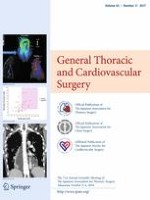Erschienen in:

08.08.2017 | Original Article
Physiological mitral annular dynamics preserved after ring annuloplasty in mid-term period
verfasst von:
Masaaki Ryomoto, Masataka Mitsuno, Mitsuhiro Yamamura, Hiroe Tanaka, Naosumi Sekiya, Hisashi Uemura, Ayaka Sato, Daisuke Ueda, Yuji Miyamoto
Erschienen in:
General Thoracic and Cardiovascular Surgery
|
Ausgabe 11/2017
Einloggen, um Zugang zu erhalten
Abstract
Objective
Mitral annular structure and dynamics after mitral ring annuloplasty using transesophageal echocardiography during the operation have been reported. We evaluated mitral annular structure and dynamics of three different rings in the mid-term period postoperatively.
Methods
Thirty-one patients underwent mitral valve repair for degenerative mitral insufficiency. The MEMO 3D ring (semi-flexible), Carpentier–Edwards Physio II ring (semi-rigid), and St. Jude Medical Rigid Saddle Ring (rigid) were implanted in 15, 12, and eight patients, respectively, from September 2009 to February 2015. Electrocardiogram-gated three-dimensional computed tomography was performed in the mid-term period postoperatively.
Results
The postoperative antero-posterior rate of reduction in diameter from end-diastole to end-systole was slightly larger in the MEMO3D (0.57 ± 0.69%) than in the Physio II (0.08 ± 0.60%) and Rigid Saddle Ring (0.11 ± 0.59%). There was no significant difference in the commissure-to-commissure rate of reduction in diameter among the groups. The postoperative end-systolic annular height to commissure width ratio was significantly larger in the Physio II (20.4 ± 1.7%) and Rigid Saddle Ring (21.3 ± 1.7%) than in the MEMO3D (10.8 ± 3.1%, both p < 0.0001). The rate of increase in the postoperative annular height to commissure width ratio from end-diastole to end-systole was significantly larger in the MEMO3D (2.1 ± 1.7%) than in the Physio II (0.1 ± 0.4%) and Rigid Saddle Ring (0.1 ± 0.6%).
Conclusions
The Physio II and Rigid Saddle Ring can restore the physiological and three-dimensional annular shape, and the MEMO3D can preserve physiological annular dynamics in mid-term period postoperatively.